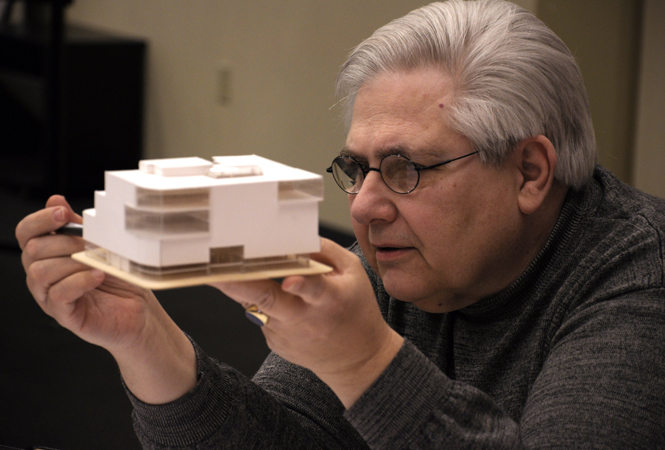Sustainable designs give new life to architecture
April 7, 2011
Caitlin Heldman always flips the light switch when she leaves a room. She unplugs wires that aren’t being used, recycles more than she throws in the trash and can’t remember the last time she bought a disposable water bottle. Until coming to college, she didn’t know some people aren’t as conscious as she is about energy consumption.
“I thought it was the norm,” said Heldman, senior interior design major. “Realizing that everyone didn’t have that same lifestyle was just a little concerning. So my roommates hate me of course.”
Heldman incorporates her passion for an eco-friendly lifestyle into her design projects. In Kent State’s College of Architecture and Environmental Design, sustainability is part of the curriculum.
To be sustainable, architects and interior designers must consider the economic, environmental and social effects of their design.
Pamela Evans, director of the interior design program, said good designers consider sustainability throughout the design process.
“I think that within the last generation and a half, people are extremely aware of the impact materials have had on health and safety and welfare,” she said. “That’s what good design is about. It’s not just about making something extremely aesthetically pleasing—that’s of course important—but it’s also about how that affects the site, how that affects the individuals, how that affects the community at large.”
Carl Bainer, an architect at Richard L. Bowen & Associates Inc. in Cleveland, said sustainability is now a significant part of the field.
Eighty percent of architects consider sustainability and climate change to be the biggest concern in the field, according to Design Intelligence, a collection of surveys of architecture professionals.
“We’re in the beginning of a very phenomenal era right now of becoming more efficient,” Bainer said. “Everyone’s on the bandwagon.”
A building consumes three to four times more energy than a car, said Charles Harker, an associate professor in architecture.
Architects can reduce a building’s energy consumption by orienting the building to best utilize the natural light and warmth of the sun, planting trees to protect from winter winds and considering the placement of windows and the insulation in the walls. They also aim to reuse and recycle materials from demolished buildings.
“There are ways of achieving energy efficiency that have been known and understood for some time that were simply ignored for quite a while because oil was cheap and plentiful,” Harker said. “Now as we’re getting to the tail end of oil availability, it’s natural that we would start thinking about how we can be more careful.”
Charles Frederick, assistant architecture professor, said the way architects practice and promote sustainability may be new, but the idea is not. For older designers in the field, sustainable design is just common sense.
Kevin Sullivan, senior architecture major, said much of what drives sustainable design comes from the simple ideas used in the past.
“I think we considered (sustainability) for a long while and then they invented the air conditioner,” Sullivan said. “We’ve come up with the technology to build anything we want wherever we want it. Yes, we can do it, but should we?”
Creating sustainable buildings; however, can be a burden.
Bridget Walsh, senior interior design major, worked on a redesign project last semester for the “Peel” Coleman Community Center in Canton. The tight budget forced students to find ways for most or all of the materials to be donated.
Because of this constraint, Walsh said she wasn’t as happy with the final product of her design.
“It complicates the design process, but that’s our job,” said Maurizio Sabini, associate professor in architecture. “We need to handle complexity. We need to create a balance between beautiful and functional, practical and sustainable.”
Taking something mediocre and making it beautiful was a creative challenge Heldman enjoyed taking on with the reused materials in the “Peel” Coleman project.
Creativity is necessary to change and improve, Harker said.
“We’re just beginning to grapple with what the appropriate responses are and how to apply them nationwide and worldwide for that matter,” he said. “It’s a very important, interesting and creative period.”
However, designers must convince clients to support the often more expensive, sustainable technologies.
“You have to really educate them on what you’re doing and why you’re doing it,” said Brandon Zawicki, senior architecture major.
Bainer said clients are gaining interest in sustainable design. He predicts the Leadership in Energy and Environmental Design building certification system created by the U.S. Green Building Council will soon become part of regular building codes. This certification system analyzes energy savings, water efficiency, C02 emissions, indoor environmental quality and stewardship of resources to provide a third-party verification that a building was designed to be sustainable.
In response to this growing activism in the design field, Mike Thomas, assistant professor in interior design, created the non-profit organization ZeroLandfill The group collects out-of-date samples and old materials from design firms. Volunteers sort and organize the materials for members of the community to take and reuse.
“What we try to teach people is that it’s really not hard to do, “ Thomas said. “You just have to try to do it and then it really becomes second nature.”
As a volunteer at ZeroLandfill, Heldman is excited by the children who come in with their families. By learning about sustainability at a young age, they can continue the movement in the future, she said.
Sullivan said sustainable design will become the norm.
“Drop the word sustainable. It’s just architecture—or it should be,” he said. “It should be the ethical, moral responsibility of the designers who have been there for 40 years and the designers that are going to be there tomorrow to be responsible for the environment.”
Contact Alyssa DeGeorge at [email protected].

























